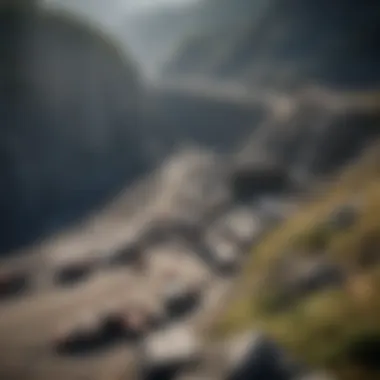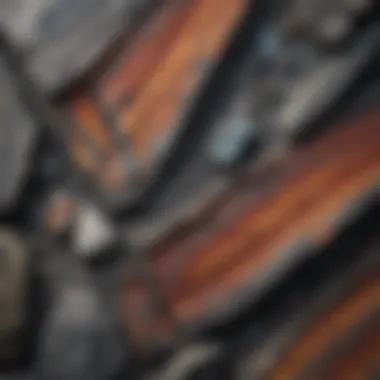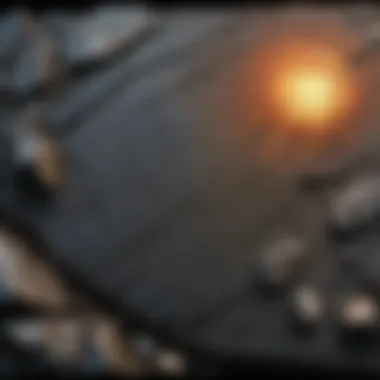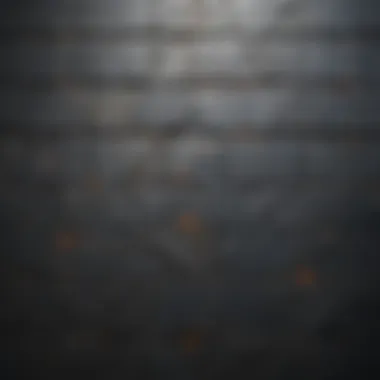Unveiling the Enigmatic Beauty of Slate Composition


Rock and Fossil Identification
Slate composition unveils a captivating world of rock types and formations, providing enthusiasts with a vast array of characteristics to explore. Identifying the distinct types of rocks and fossils within slate entails a keen eye for detail and an understanding of the unique features each specimen exhibits. From the texture and color patterns to the mineral composition, examining these elements requires careful observation. Specialized tools such as magnifying glasses, hardness picks, and UV lights can aid in the comprehensive identification process, enabling collectors to distinguish subtle differences and classify specimens accurately.
Geological Insights
Delving into the geological insights offered by slate composition illuminates the intricate formations and processes that have shaped these rock formations over time. Understanding the geological origins of slate involves unraveling complex layers of sedimentation and metamorphism, revealing the historical significance embedded within each stratum. From tectonic movements to volcanic activity, the geological forces at play in the formation of slate contribute to its distinctive properties and textures. Exploring notable discoveries in the field of geology unveils a rich tapestry of findings that showcase the diversity and evolution of slate compositions across various regions.
Preservation and Display
Preserving the beauty and integrity of slate rocks and fossils necessitates adopting sound techniques and methods to ensure their longevity. Implementing proper storage practices, such as utilizing moisture-resistant containers and climate-controlled environments, can safeguard specimens from degradation and damage. Creative display ideas enhance the aesthetic appeal of collected slate compositions, allowing enthusiasts to showcase their prized acquisitions in visually captivating ways. From shadow boxes to museum-style exhibits, the art of presentation adds a new dimension to the appreciation of slate's intricate beauty and geological significance.
Collecting Tips and Techniques
Embarking on the journey of collecting slate rocks and fossils requires adherence to best practices and techniques that optimize the gathering process. Locating prime collecting sites with abundant deposits of slate formations involves research and exploration, scouting for areas rich in geological diversity and preservation. Safely extracting specimens from their natural habitats demands delicate handling and precision tools to avoid damaging the fragile structures. By following expert advice and honing collecting skills, enthusiasts can enrich their collections with unique and valuable specimens, further deepening their understanding of slate composition and its vast intricacies.
Introduction to Slate Composition
Slate composition is a topic of immense significance in the realm of geology and rock formations. Understanding the intricacies of slate opens doors to a world filled with geological wonder and practical applications. Within the context of this article, delving into the essence of slate composition provides a foundation for comprehending its origins, properties, and diverse uses.
Defining Slate
Origins and Formation
Exploring the origins and formation of slate unveils a fascinating journey of metamorphic transformation and geological processes. The gradual evolution from sedimentary rock to slate showcases nature's ability to create a rock with unique characteristics and properties. The compression and heating that slate undergoes during its formation contribute to its remarkable durability and distinctive texture, making it a sought-after material for various applications in construction and design.
Distinctive Properties
The distinctive properties of slate, such as its foliated structure and excellent cleavage, set it apart from other rocks. These properties not only make slate suitable for roofing and flooring but also for artistic endeavors and creative expression. The natural color variations and fine-grained texture of slate add aesthetic value to its functional benefits, making it a versatile choice for architectural and decorative purposes.
Historical Significance
Ancient Uses
Exploring the ancient uses of slate reveals its historical importance as a versatile material utilized by civilizations for tools, writing surfaces, and artistic creations. The durability and longevity of slate made it a valuable resource in shaping early human societies and civilizations. From creating tablets for writing to crafting tools for everyday use, slate played a pivotal role in ancient economies and cultural development.
Cultural Symbolism
The cultural symbolism associated with slate speaks volumes about its enduring presence in human history and traditions. From being revered as a symbol of strength and resilience to its use in ceremonies and rituals, slate holds a pivotal position in various cultural expressions worldwide. The significance of slate in art, folklore, and spiritual practices underscores its timeless appeal and symbolic richness in the ethnographic tapestry of human society.
Geological Insights
Slate composition is a cornerstone of geological insights in this comprehensive article. By delving into the intricate details of slate formation, readers will discover the significance of understanding the geological processes that give rise to this versatile rock. The relevance of geological insights lies in unraveling the complexities of metamorphic transformation and the effects of pressure and heat on slate formation. By exploring these topics, individuals gain a deeper appreciation for the unique properties of slate, making it a vital component of this discourse.
Slate Formation Process
Metamorphic Transformation:
The metamorphic transformation of slate is a pivotal aspect crucial to comprehending its composition. This process involves the alteration of pre-existing rock through immense pressure and heat, leading to the creation of slate's distinct foliation and durability. The key characteristic of metamorphic transformation lies in its ability to convert existing rocks like shale into slate, conferring upon it remarkable strength and resilience. Its unique feature includes the alignment of mineral grains, ensuring slate's renowned splitting ability, a valuable trait highlighted in this discourse.


Pressure and Heat Effects:
The effects of pressure and heat play a pivotal role in shaping slate's formation and properties. Under intense geological forces, sedimentary rocks undergo compaction and recrystallization, transforming into the fine-grained structure characteristic of slate. The key characteristic of pressure and heat effects is their capability to induce profound changes in rock composition, resulting in the unique textures and colors found in slate. While advantageous for creating robust and enduring slate formations, these effects may limit color variations and influence the overall aesthetic appeal of the rock, aspects examined closely in this article.
Mineral Composition
Primary Minerals:
The primary minerals found in slate contribute significantly to its overall constitution and structural integrity. By examining these minerals, individuals can appreciate the fundamental components that define slate's physical characteristics. The key characteristic of primary minerals lies in their composition of quartz, mica, chlorite, and other essential minerals, enhancing slate's durability and strength. Furthermore, the unique feature of primary minerals lies in their role in defining the distinct color variations and textures present in different types of slate, providing a fascinating insight into the rock's geologic history and formation processes.
Impurities and Color Variations:
Impurities and color variations in slate offer a nuanced perspective on the rock's mineral composition and aesthetic appeal. The presence of impurities such as iron oxide or organic matter can impart diverse hues to slate, ranging from classic grey tones to vibrant reds and blues. These color variations, while adding visual interest to slate, may also influence its durability and weathering characteristics. Understanding the interplay between impurities and color variations is essential for appreciating the diverse geological factors that shape slate composition, an exploration intricately woven into this article's narrative.
Types of Slate
Regional Variations
Slate Deposits Around the World
Within the purview of 'Regional Variations,' the exploration of 'Slate Deposits Around the World' unravels a crucial facet of global slate composition. The distinctive characteristics of slate deposits worldwide play a significant role in determining the quality and aesthetic appeal of the slate sourced from different regions. Understanding the geological formations and mineral compositions specific to each locale provides valuable insight into the variations in color, texture, and durability of slate. The abundance or scarcity of particular minerals in these deposits influences the overall quality and market value of the slate, presenting both advantages and disadvantages for potential applications.
Specialized Variants
Architectural Slate
The segment dedicated to 'Architectural Slate' accentuates the importance of this specialized variant within the broader discussion of slate composition. Architectural slate stands out for its durability, weather resistance, and elegant aesthetics, making it a preferred choice for roofing and cladding in architectural design. Its natural beauty and thermal insulating properties further underline its significance in construction projects seeking both functionality and visual appeal. Despite potential challenges in sourcing and cost, architectural slate remains a popular and advantageous option for high-end architectural applications.
Artistic Applications
Turning our focus to 'Artistic Applications,' this specialized variant embodies the creative potential and aesthetic diversity of slate composition. As a medium for sculptures, artwork, and unique craftsmanship, slate offers artists a versatile canvas to explore texture, form, and color in their creations. The inherent variations in slate's color patterns and grain add a dimension of depth and character to artistic endeavors, distinguishing it as a sought-after material in the realm of art and design. While artistic applications showcase the beauty and creative possibilities of slate, considerations such as fragility and specialized handling requirements pose challenges alongside the artistic benefits in utilizing slate for such purposes.
Properties and Characteristics
In this section of the article uncovering the intricacies of Slate Composition, we delve into the fundamental aspects that define and differentiate this versatile rock. Properties and characteristics play a pivotal role in understanding slate, influencing its applications and significance in various industries. By exploring the physical and functional attributes of slate, we gain a comprehensive insight into its value and versatility.
Physical Attributes
Texture and Grain Size
Examining the texture and grain size of slate provides vital insights into its appearance and quality. The texture determines the feel and appearance of the slate surface, with variations ranging from smooth to rough textures. Grain size relates to the size of mineral particles within the slate, affecting its strength and durability. The unique feature of slate lies in its fine-grained texture and uniform grain size, which contribute to its ease of splitting and shaping, making it a preferred choice for roofing and flooring applications. While the fine texture enhances aesthetics, it may pose challenges in terms of grip on flooring surfaces.
Durability and Weathering
The durability and weathering characteristics of slate define its resilience to external factors and long-term performance. Slate exhibits exceptional durability, resisting impact damage and weathering due to its compact structure and low porosity. This feature ensures longevity and minimal maintenance requirements, making slate a sustainable building material. However, despite its durability, slate is susceptible to chipping and flaking over time, particularly in harsh weather conditions. Regular maintenance and protective coatings are essential to preserve its pristine appearance and structural integrity.
Functional Qualities
Water Absorption Rate
Understanding the water absorption rate of slate is essential for assessing its suitability in various applications. The low water absorption rate of slate signifies its impermeability to moisture, making it an ideal choice for outdoor installations such as roofing. This property ensures minimal water damage and prevents discoloration or mold growth on the surface. However, in areas with high humidity levels, increased water absorption may lead to delamination or efflorescence, affecting the structural stability of the slate.


Thermal Insulation
The thermal insulation capabilities of slate play a crucial role in regulating indoor temperature and energy efficiency. Slate exhibits excellent thermal inertia, maintaining a stable temperature within the building envelope and reducing reliance on heating or cooling systems. This natural insulation property makes slate an eco-friendly and cost-effective construction material. Nevertheless, proper installation techniques and insulation practices are imperative to maximize the thermal efficiency of slate and minimize heat loss or gain. Balancing thermal insulation with ventilation is essential to create a comfortable and energy-efficient living environment.
Applications and Uses
In the realm of slate composition, understanding its applications and uses is paramount to grasping the full scope of this versatile rock formation. Slate holds a prominent place in the construction industry and is prized for its exceptional durability and aesthetic appeal. Exploring the various ways in which slate is utilized offers insights into its functional and decorative capacities, making it a valuable asset in architectural endeavours.
Construction Industry
Slate plays a crucial role in the construction industry, particularly in two key areas: roofing material and flooring and wall cladding.
Roofing Material
Slate's usage as a roofing material stands out due to its resilience and distinct appearance. The key characteristic of slate as a roofing material lies in its longevity and weather-resistant properties, making it a popular choice for roofing projects. Its unique feature of withstanding harsh environmental conditions while maintaining its elegance positions it as a highly advantageous option for durable and visually appealing rooftops.
Flooring and Wall Cladding
When it comes to flooring and wall cladding, slate offers a blend of aesthetic charm and practical functionality. The key characteristic of slate in these applications is its strength and natural beauty, rendering it a sought-after choice for adding sophistication to interior spaces. The unique feature of slate lies in its versatility, enabling it to be fashioned into various sizes and finishes, though proper sealing is necessary to prevent staining. Understanding the advantages and disadvantages of utilizing slate for flooring and wall cladding is essential for optimizing its use in construction projects.
Artistic and Decorative
Beyond its utilitarian roles, slate finds expression in artistic and decorative realms, enhancing creative pursuits and interior design elements.
Sculptures and Craftsmanship
Slate's presence in sculptures and craftsmanship reflects its adaptability and aesthetic appeal. The key characteristic of using slate in sculptures and craftsmanship is its malleability, allowing artisans to create intricate designs with precision. This unique feature of slate lends itself to the creation of detailed artworks, though its weight can pose challenges during handling. Recognizing both the advantages and disadvantages of employing slate in sculptural endeavors enriches the artistic process.
Interior Design Elements
In interior design, slate serves as a distinctive element imbuing spaces with sophistication and character. The key characteristic of slate in interior design lies in its texture and color variations, offering a visually striking and elegant solution for enhancing interiors. The unique feature of slate as an interior design element is its ability to add a touch of natural beauty while requiring minimal maintenance. Evaluating the advantages and disadvantages of integrating slate into interior design schemes is crucial for achieving harmonious and aesthetically pleasing spaces.
Maintenance and Care
Maintaining and caring for slate is a critical aspect to ensure its longevity and preserve its aesthetic appeal. This section will delve into the intricacies of proper maintenance practices and highlight essential care considerations for this versatile rock formation. By understanding the importance of maintenance and care, readers can optimize the lifespan and quality of their slate surfaces. From routine upkeep to specialized treatments, the maintenance and care of slate play a pivotal role in upholding its durability and visual allure.
Cleaning Techniques
- Regular Maintenance Tips
Regular Maintenance Tips
When it comes to regular maintenance tips for slate, attention to detail is key. Implementing a consistent cleaning routine can prevent dirt and grime buildup, maintaining the natural beauty of the slate surface. Regularly sweeping or vacuuming the slate floors and surfaces can prevent scratches and abrasions, preserving its texture and finish. Additionally, using a mild detergent or specialized slate cleaner along with a soft sponge or cloth can effectively remove surface dirt and stains without damaging the slate composition. Embracing these regular maintenance tips can prolong the life of slate installations, ensuring they remain pristine and visually appealing.
- Stain Removal Strategies
Stain Removal Strategies
Stains on slate surfaces can be daunting, but with the right strategies, they can be effectively eliminated. Stain removal strategies for slate involve targeted treatments based on the type and severity of the stain. From oil-based stains to watermarks, each stain requires a specific approach for successful removal. Utilizing poultices, baking soda solutions, or specialized stain removers can help lift stubborn stains from slate surfaces without causing discoloration or harm. By understanding the unique properties of slate and implementing tailored stain removal strategies, individuals can maintain the integrity and aesthetic value of their slate installations.
Longevity Preservation


- Sealing and Protective Coatings
Sealing and Protective Coatings
Preserving the longevity of slate surfaces often involves the application of sealing and protective coatings. Sealants create a protective barrier that shields slate from moisture, stains, and scratches, enhancing its resilience and durability. By sealing slate surfaces, individuals can mitigate the risk of water damage and maintain the natural luster of the stone. Choosing quality sealants and applying them according to manufacturer guidelines is crucial for maximizing the efficacy of protective coatings in safeguarding slate installations over time.
- Preventive Measures
Preventive Measures
Incorporating preventive measures is instrumental in safeguarding slate surfaces against damage and wear. Preventive measures may include placing coasters under heavy objects to prevent scratches, using furniture pads to avoid surface abrasions, and promptly addressing spills to prevent staining. Additionally, utilizing mats at entryways can reduce dirt and debris accumulation on slate floors, minimizing the need for frequent cleaning and maintenance. By proactively implementing preventive measures, individuals can uphold the longevity and aesthetics of their slate surfaces, ensuring lasting beauty and functionality.
Environmental Impact
Sustainability Factors
Extraction Practices
Delving into the realm of extraction practices illuminates a crucial facet of the slate industry's environmental impact. The meticulous extraction process plays a fundamental role in determining the sustainability of slate usage. Whether it involves quarrying methods or waste management strategies, the sustainability of extraction practices underscores the need for responsible resource utilization. Assessing the environmental repercussions and benefits of various extraction methods unveils the intricate balance between industry demands and ecological preservation. Evaluating the environmental footprint of extraction techniques reveals insights into minimizing impact and fostering sustainable practices within the slate sector.
Recycling and Reuse Initiatives
Exploring recycling and reuse initiatives within the realm of slate composition unveils a realm of key considerations and innovative solutions. Encouraging the repurposing of slate waste and promoting circular economy principles, recycling initiatives offer a sustainable approach to handling slate residues. The utilization of recycled slate materials not only reduces landfill burden but also contributes to conservation efforts by minimizing resource exploitation. Evaluating the advantages and disadvantages of recycling and reuse initiatives sheds light on the economic, environmental, and social benefits of such practices. Embracing recycling as a cornerstone of sustainability within the slate domain epitomizes a progressive stance towards resource stewardship.
Carbon Footprint
Eco-Friendly Alternatives
Examining eco-friendly alternatives in the backdrop of slate composition accentuates a pivotal juncture in environmental consciousness. From exploring renewable energy sources for slate extraction to adopting sustainable transportation methods for distribution, eco-friendly alternatives present a paradigm shift in mitigating carbon emissions. The integration of green technologies and environmentally-friendly practices not only reduces the carbon footprint of slate operations but also fosters a culture of innovation and environmental responsibility. Analyzing the advantages and disadvantages of eco-friendly alternatives unveils the transformative potential of aligning industrial practices with ecological preservation objectives.
Green Building Trends
Delving into the realm of green building trends imparts a holistic perspective on sustainable construction practices within the slate industry. Embracing energy-efficient designs, green certifications, and eco-conscious building materials, green building trends redefine architectural landscapes. The symbiotic relationship between slate composition and green building trends resonates with a shared commitment to sustainability and environmental stewardship. Evaluating the advantages and disadvantages of integrating green building trends within slate applications underscores the profound impact of conscientious design and construction methodologies. By championing green building trends, the slate sector catalyzes a positive shift towards sustainable development and environmental resilience.
Future Prospects
In this section devoted to exploring the future prospects of slate composition, we delve into the potential advancements and emerging trends that may revolutionize the industry. The discussion centers on the evolving landscape of slate utilization and the innovative strategies shaping its trajectory. By analyzing the current market demands and technological advancements, we aim to provide insights into what the future holds for slate composition.
Technological Advancements
Innovative Applications
Within the realm of innovative applications in slate composition, a paradigm shift is imminent. The focus is on pushing the boundaries of traditional uses and embracing a more modern approach to leveraging slate's unique properties. Innovative applications open up avenues for groundbreaking designs in architecture and art, fostering a creative renaissance within the industry. The key characteristic lies in the fusion of functionality and aesthetics, offering a blend of durability and artistic expression. Despite some challenges in implementation, the adaptability of slate in innovative projects renders it a popular choice among industry professionals seeking to redefine conventional norms.
Research and Development
Research and development stand as the bedrock of progress in slate composition, driving exploration into uncharted territories and refining existing practices. This facet underscores the continuous quest for improving techniques, sustainability, and performance of slate products. The key characteristic revolves around experimentation and data-driven decision-making, propelling the industry towards more efficient and eco-friendly solutions. While the journey may pose hurdles like resource constraints and uncertainty, the benefits of enhanced product quality and environmental impact reduction make research and development an indispensable component in the evolution of slate composition.
Market Trends
Demand Forecast
A critical aspect of understanding the market dynamics of slate composition is delving into demand forecast trends. By analyzing consumer preferences, economic indicators, and industry developments, we gain valuable insights that inform production and distribution strategies. The key characteristic of demand forecast lies in its predictive nature, aiding stakeholders in anticipating market shifts and adapting proactively. While challenges such as volatile demand patterns and external influences exist, the advantages of informed decision-making ensure the sustained growth and relevance of slate composition in the market.
Industry Growth Opportunities
Exploring industry growth opportunities in slate composition unveils a landscape ripe with potential for expansion and innovation. Recognizing emerging niches, diversification possibilities, and collaborative ventures form the cornerstone of industry growth strategies. The key characteristic centers on fostering partnerships, harnessing technological advancements, and exploiting niche markets to drive sustainable development. Despite facing obstacles like regulatory hurdles and competitive landscapes, the advantages of scalability and diversification position industry growth opportunities as catalysts for shaping the future trajectory of slate composition.







